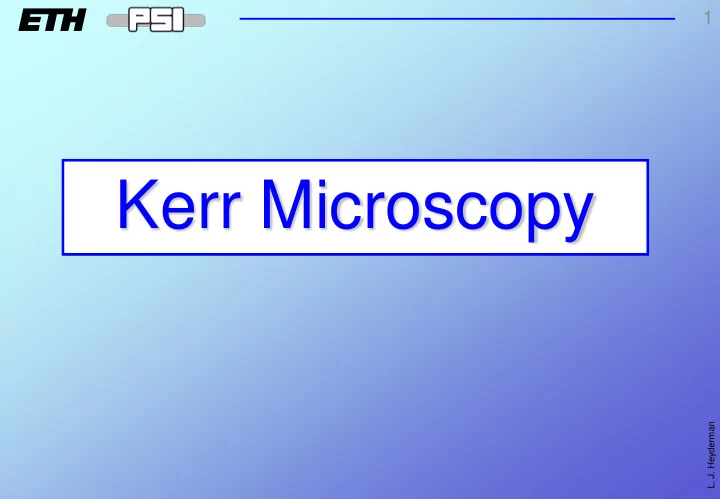

1 Kerr Microscopy L. J. Heyderman
2 Kerr Effect 1845 1877 L. J. Heyderman Rudolf Schäfer — IFW Dresden
3 Kerr Effect Rudolf Schäfer — IFW Dresden http://cddemo.szialab.org L. J. Heyderman
4 Kerr Effect L. J. Heyderman Rudolf Schäfer — IFW Dresden
5 Kerr Effect Longitudinal L. J. Heyderman Rudolf Schäfer — IFW Dresden
6 Kerr Effect – Lorentz Concept Linearly polarized light will induce electrons to oscillate parallel to its plane of polarization – the plane of the electric vector E of light Longitudinal Secondary motion is proportional to –M x E, and generates the Kerr amplitude, A K , for reflection rotation of polarisation Opposite M direction L. J. Heyderman opposite Kerr rotation Rudolf Schäfer — IFW Dresden
7 Kerr Microscopy • Based on small rotations of the polarization plane of light • Linearly polarized light will induce electrons to oscillate parallel to its plane of polarization – the plane of the electric vector E of light • Regularly reflected light is polarised in the same plane as the incident light: A N component • Spin-orbit interaction induces a small component of vibrational motion perpendicular to original motion and to direction of magnetisation • Secondary motion which is proportional to –M x E, and L. J. Heyderman generates the Kerr amplitude, A K , for reflection Hubert & Schäfer, Magnetic Domains
8 http://www.physik.fu-berlin.de/~bauer/habil_online/node9.html Image Signal If total signal amplitude: A TOT = A N +/- A K (normal & Kerr) Then Kerr Rotation: φ K = A K / A N Start with α S = φ K ; extinguishes light from one domain; one domain appears dark and the other light Actually better to rotate the analyser beyond the extinction point. In practice, adjust polarizer and analyser until an image of L. J. Heyderman satisfactory contrast and brightness is obtained. Hubert & Schäfer, Magnetic Domains
9 Polarising Microsope http://physics.nist.gov/Divisions/Div841/Gp3/Facilities/kerr.html L. J. Heyderman http://www.fkf.mpg.de/kern/facilities/kerr/kerr.html
10 Digital Image Enhancement Digital difference technique: non-magnetic background image is digitally subtracted Spatial resolution: ∼ 200 nm L. J. Heyderman http://physics.nist.gov/Divisions/Div841/Gp3/Facilities/kerr.html
11 Rudolf Schäfer IFW Dresden L. J. Heyderman objective
12 Observation of Quasi-domain Walls Twin Walls Ferromagnetic Thin Film Non-magnetic Spacer Layer Ferromagnetic Thin Film Kerr Microscopy Image shows domain wall (black line) and quasi-domain wall (white line) in top layer of L. J. Heyderman sandwich film
13 Time-Resolved Kerr Microscopy Stroboscopic technique: • Short field pulses (e.g. 20 ns, 10 kA/m) with copper microstrip line • With a defined time delay, the magnetization is probed • Reasonable signal-to-noise ratio by integrating the optical signal • Accumulation over repeatable magnetization processes is required. • Gated & intensified CCD camera providing temporal resolution down to 200 ps L. J. Heyderman Chumakov, McCord, Schäfer, Schultz
14 Time-Resolved Kerr Microscopy Applied Field: quasi-static reversal Applying a field pulse: magnetization not able to instantaneously follow magnetic field. To reach new magnetization direction, will have to spin about the field axis: Applied Field Pulse: time-resolved precessional motion that is gradually opposed by damping. Reversal looks very L. J. Heyderman different! Chumakov, McCord, Schäfer, Schultz
15 Kerr Microscopy Summary • Flat and smooth surface • Spatial resolution ∼ 200 nm • Magnetization can be observed directly • Quantitative measurements possible but need to take care with calibration • Observation does not influence magnetization • Dynamic processes can be observed at high speed • Sample may be easily manipulated: fields, high or low temperature, mechanical stress • Surface magnetization: penetration depth of 10-20 nm L. J. Heyderman • Can look at back and front of sample Hubert & Schäfer, Magnetic Domains
Recommend
More recommend